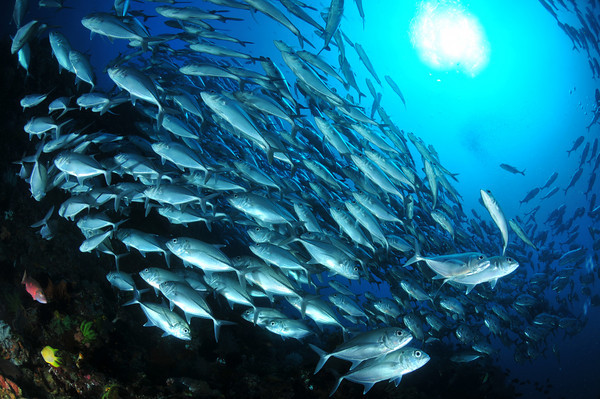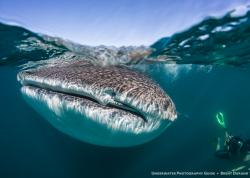Photographing Sunbursts & Sunballs

Schooling jacks with a sunball in the background. F13, 1/250th, ISO 200
Viewing a sunburst underwater can be very beautiful. Photographing it can be very difficult.
When taking underwater photographs with the sun in the frame, I recommend you shoot at as fast of a shutter speed as possible, at base ISO for maximum dynamic range. Sunbursts are best in water with some particles in them, so the sunbeams appear in the water. If you are also lighting up a foreground subject with strobes, make sure your shutter speed is as fast as possible without exceed the strobe sync speed of your camera. Sunbursts often have unpleasant rings around them when overexposed, so check your stops and stop down your aperture if needed.
To get a properly exposed sunburst, you will also be shooting at a small aperture, most likely between F11 and F22 (or F8 with a compact camera). To light up a foreground subject at these small apertures, you will either need very strong (expensive) strobes, or you will have to bring your strobes as close to the subject as possible. If necessary, you can remove your strobe diffusers for a little more power. This is where cameras with a fast sync speed have an advantage.

Soft coral with sunball, photo by Todd Winner. Being down deep helped make it possible to shoot the sunball at F10 without overexposing it by too much. F10, 1/250th, ISO 100, tokina 10-17mm at 10mm. This shot was taken below the soft coral, just a foot away from it, shooting straight up.

Particles in the water and being shallow helped bring out the sunbeams. Shot at 1/320th of as second, F11 - my strobes also lit up the kelp a little, I had to be very close.

Sunburst combined with a silhouette. Practise getting the right exposure on the sunburst before the right subject comes along for the silhouette. Photo by Rand McMeins.

Sunburst, photo by Rand McMeins. D2x, F10, 1/250th, ISO 100. Once your sunbursts look like this, you can start adding foreground subjects. Your camera will need a high dynamic range, such as a Canon 7D, 5D, Nikon D2X or Nikon D300, D7000, D800.
Sunbursts often look best when partially hid by a subject.


Both photos by Rand McMeins. In the coral photo, strobes were used to light the subject. Very strong strobes are needed, or a very close strobe to subject distance, due to the smaller apertures necessary for these shots. Oly 5050Z, F8, 1/1000th, ISO64

Soft coral from Fiji, strobe lit, sunburst partially hidden. Photo by Rand McMeins. Oly 5050Z, F8, 1/1000th, ISO64
Sunburst and sunball photography tips:
Shoot at a low ISO, high shutter speed, small aperture
If using strobes, get them very close to your subject to ensure they light the subject
Hide the sun behind an object if possible
Sunbeams are very difficult in clear water, it helps if there are some particulates
Sunbeams are best captured close to the surface
Be careful not to over-expose a sunburst. Underexposure is best.
Turn off your strobes for an ambient light shot or silhouette shot, then you can shoot faster than your strobe sync speed
Strong strobes like the Sea & Sea YS-D1, Ikelite DS-160, or YS-250 work well when shooting into the sun at small apertures

Lionfish in Anilao, Philippines. F22, 1/250th, ISO 100, dual Sea & Sea YS-D1 strobes on full power
Further Reading


RECOMMENDED ARTICLES
SUPPORT THE UNDERWATER PHOTOGRAPHY GUIDE:
The Best Service & Prices on u/w Photo Gear
 Visit Bluewater Photo & Video for all your underwater photography and video gear. Click, or call the team at (310) 633-5052 for expert advice!
Visit Bluewater Photo & Video for all your underwater photography and video gear. Click, or call the team at (310) 633-5052 for expert advice!
The Best Pricing, Service & Expert Advice to Book your Dive Trips
 Bluewater Travel is your full-service scuba travel agency. Let our expert advisers plan and book your next dive vacation. Run by divers, for divers.
Bluewater Travel is your full-service scuba travel agency. Let our expert advisers plan and book your next dive vacation. Run by divers, for divers.































